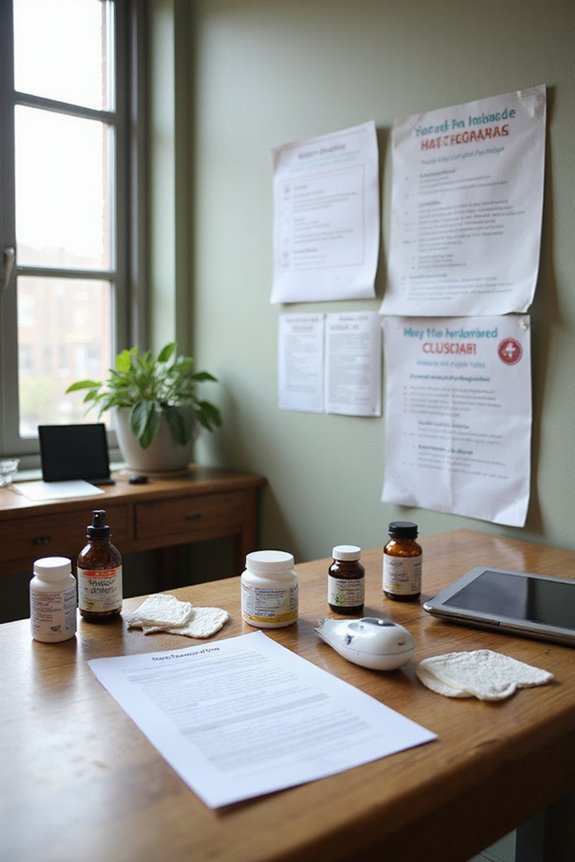Pain treatments adapt to different populations through careful consideration of various factors.
- Chronic pain prevalence differs across groups, influencing treatment approaches.
- Socioeconomic status greatly affects access to pain management options.
- Age influences preferences for treatment, with children and older adults requiring tailored strategies.
- Sex-specific responses to pain necessitate unique treatment protocols.
- Cultural beliefs shape pain perception and expression, impacting clinical assessments.
Understanding these factors is essential for developing effective pain management strategies that meet diverse needs. Further exploration yields deeper insights.
Key Takeaways
- Pain treatments are tailored based on cultural beliefs, influencing patient expectations and acceptance of various therapeutic approaches.
- Socioeconomic status significantly affects access to pain management options, leading to disparities in treatment availability and effectiveness.
- Age-related differences necessitate distinct pain management strategies, as treatment needs vary between pediatric and geriatric populations.
- Sex-specific considerations are crucial, as women may require different analgesics and approaches due to heightened sensitivity and hormonal influences.
- Healthcare providers must develop cultural competence to effectively communicate and adapt pain management strategies to diverse patient backgrounds.
Disparities in Chronic Pain Prevalence
Chronic pain prevalence varies markedly across different racial and ethnic populations, highlighting critical disparities that warrant attention.
- Asian Americans report the lowest chronic pain rates across studied definitions.
- Native Americans and multiracial adults exhibit the highest prevalence, particularly in severe pain categories.
- Hispanics show lower pain prevalence than Whites and Blacks, a difference not attributed to immigrant status or socioeconomic factors.
- Whites, Blacks, and Hispanics fall in the mid-range of chronic pain prevalence, with differences in severity noted.
- Blacks report less prevalence of mild pain but higher rates of severe pain compared to Whites.
These racial pain disparities underscore the importance of understanding ethnic pain prevalence to inform effective treatment strategies.
Tailoring Pain Treatments for Socioeconomic Factors

How can pain treatments be effectively tailored to accommodate socioeconomic factors? Addressing socioeconomic barriers is vital for improving treatment accessibility. Key considerations include:
- Access Disparities: Low- and middle-income regions frequently lack essential analgesics, particularly opioids, creating significant gaps in pain management.
- Chronic Pain Incidence: Individuals below the poverty line are more susceptible to severe pain conditions, with lower education correlating to higher pain prevalence.
- Economic Limitations: Financial constraints often hinder access to multimodal pain management, resulting in reliance on less effective treatments.
- Provider Bias: Implicit biases related to socioeconomic status can lead to unequal treatment outcomes. Training interventions have shown promise in reducing these disparities.
Addressing these factors is essential to guarantee equitable pain management across diverse socioeconomic groups.
Age-Appropriate Pain Management Strategies

Effective pain management strategies vary greatly across age groups, necessitating tailored approaches to meet the unique needs of each demographic.
Infant Strategies
- Nonpharmacologic methods, such as breastfeeding and oral sucrose, effectively reduce pain.
- Comfort techniques like swaddling and skin-to-skin contact are recommended.
Toddler Techniques
- Distraction methods, including toys and bubbles, are effective in pain management.
- Comfort holds by caregivers enhance security and coping.
School Age Methods
- Engagement with video games and cognitive-behavioral therapies can markedly reduce pain.
- Restoration of normal activities is essential for chronic pain management.
Adolescent Approaches
- Autonomy in pain management choices is vital.
- Multimodal strategies, incorporating physical and psychological therapies, optimize outcomes.
Sex-Specific Considerations in Pain Treatment

Sex-specific considerations in pain treatment are essential due to the inherent biological and psychological differences between men and women.
- Women generally exhibit heightened pain sensitivity, frequently experiencing more severe chronic pain conditions, such as fibromyalgia and migraines.
- Hormonal fluctuations, particularly estrogen, greatly influence pain perception, with increased sensitivity reported during certain menstrual phases.
- Functional differences in nociceptors between sexes affect pain processing, suggesting the need for tailored treatments.
- Studies indicate that analgesic responses vary, with some medications proving more effective for one sex over the other.
- The prevalence of pain-related catastrophizing in women further complicates their pain experiences and treatment outcomes.
These factors necessitate a more nuanced, sex-aware approach in pain management strategies.
Cultural Responsiveness in Pain Management

Cultural responsiveness in pain management recognizes that cultural norms markedly influence pain perception and treatment-seeking behaviors. Understanding these influences is critical for effective care.
- Cultural Beliefs: Different cultural groups may have unique beliefs about pain, shaping their experiences and expectations for treatment.
- Pain Expression: Pain can be expressed openly or suppressed based on cultural norms, affecting reporting accuracy and treatment decisions.
- Pharmaceutical Acceptance: Some cultures may resist analgesics, particularly opioids, due to concerns about addiction.
- Pain Thresholds: Cultural factors also play a role in pain tolerance and threshold levels, impacting clinical assessments.
Healthcare providers must develop cultural competence to navigate these complexities, enhancing communication and improving patient outcomes in diverse populations.
Psychological and Behavioral Approaches to Pain
How do psychological and behavioral approaches contribute to effective pain management?
- Cognitive Behavioral Therapy (CBT) Effectiveness: CBT is the most evidence-supported psychological treatment for chronic pain, demonstrating improvements in pain, mood, and disability across diverse populations.
- Behavioral Reinforcement: Techniques such as structured activity scheduling and graded exposure promote adaptive behaviors, enhancing long-term pain coping and reducing disability.
- Emotional Resilience: Psychological interventions, including mindfulness and relaxation training, aim to modify pain-related thoughts and emotions, fostering resilience against chronic pain.
- Collaborative Models: Engaging patients in understanding the biopsychosocial nature of pain increases acceptance of psychological interventions, improving treatment outcomes.
These approaches, while modest in effect size, are integral components of a thorough pain management strategy, enhancing overall quality of life.
Impact of Access and Insurance on Treatment Modalities
Access to pain management services is considerably influenced by insurance coverage and socioeconomic factors.
- Uninsured individuals encounter significant insurance barriers, limiting their access to specialized pain care.
- Medicaid enrollees often face provider shortages, leading to delays in treatment.
- Private insurance plans vary in coverage, impacting the affordability of different treatment modalities.
- High out-of-pocket costs for non-pharmacological therapies deter low-income populations from seeking necessary care.
- Individuals from lower socioeconomic backgrounds frequently prioritize pharmacologic treatments due to limited access to extensive pain management strategies.
- Geographic disparities further exacerbate these issues, particularly in rural areas with fewer specialists and inadequate insurance network participation.
Policy Adjustments for Equitable Pain Management
In order to address the disparities in pain management, policy adjustments must focus on equitable access and treatment for all populations. Effective policy frameworks should include:
- Mandated training for healthcare providers to recognize and mitigate implicit biases.
- Incorporation of cultural humility in clinical guidelines to enhance patient-centered communication.
- Standardized pain assessment tools to minimize subjective bias.
- Ongoing education about intersectionality’s impact on pain perception.
Additionally, equity initiatives should promote:
- Trauma-informed models that consider patients’ lived experiences.
- Multidisciplinary collaboration in complex pain cases.
- Disaggregated data collection to identify treatment disparities.
These thorough adjustments can foster an inclusive environment, ultimately improving pain management outcomes across diverse demographic groups.
Frequently Asked Questions
How Do Genetics Influence Individual Pain Responses and Treatment Outcomes?
Genetic variability greatly influences individual pain sensitivity, shaping responses to treatment. Variations in genes affect pain perception, opioid metabolism, and chronic pain susceptibility, highlighting the necessity for personalized approaches in managing pain effectively across diverse populations.
What Role Do Alternative Therapies Play in Pain Management Across Populations?
In 2022, 49.2% of U.S. adults embraced alternative therapies for pain management. Acupuncture benefits, yoga practices, and herbal remedies reflect diverse cultural beliefs, with holistic approaches integrating mindfulness techniques for thorough pain relief across populations.
How Can Technology Improve Pain Treatment Accessibility for Diverse Groups?
Technology enhances pain treatment accessibility through telehealth solutions, mobile applications, and remote monitoring. Community outreach and digital education foster inclusivity, while virtual support creates a sense of belonging, empowering diverse groups to manage pain effectively.
What Are the Long-Term Effects of Chronic Pain on Mental Health?
Chronic pain greatly impacts mental health, often leading to heightened rates of anxiety and depression. This interplay can create a cycle of emotional distress, further complicating both pain management and overall quality of life for affected individuals.
How Can Community Support Systems Enhance Pain Management Effectiveness?
In the warm embrace of community, peer support blossoms, fostering resilience. Culturally sensitive networks weave connections, enhancing pain management effectiveness. Together, individuals find strength, transforming isolation into belonging, and guiding treatment journeys with shared understanding and compassion.




